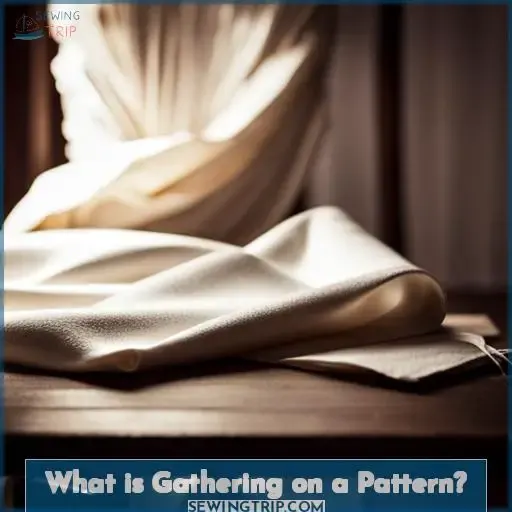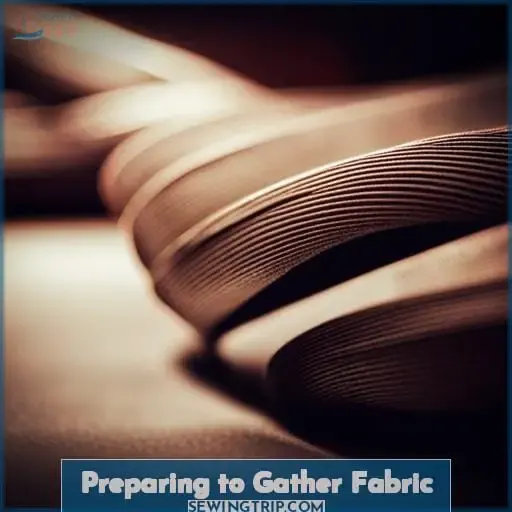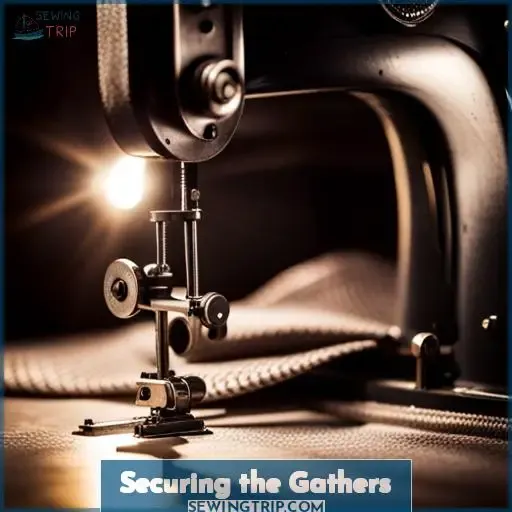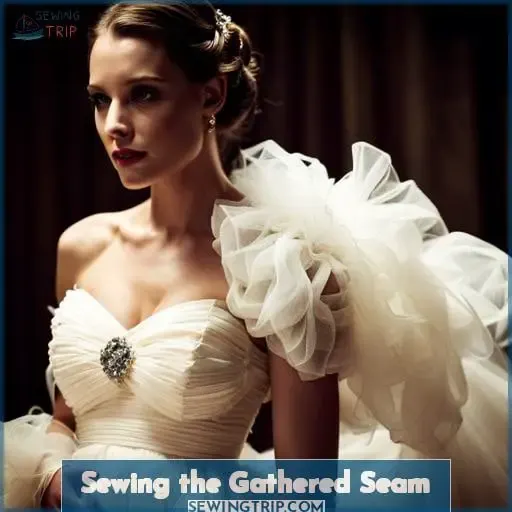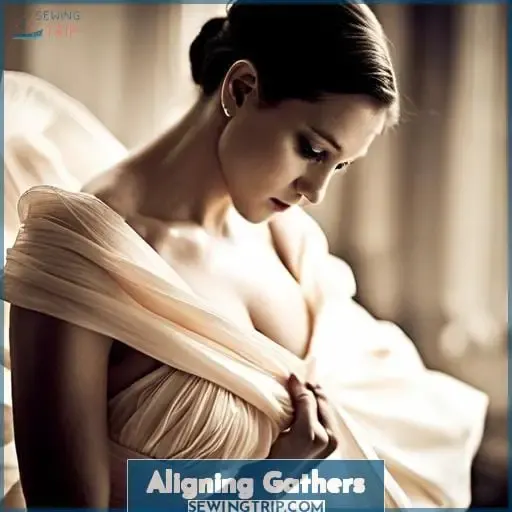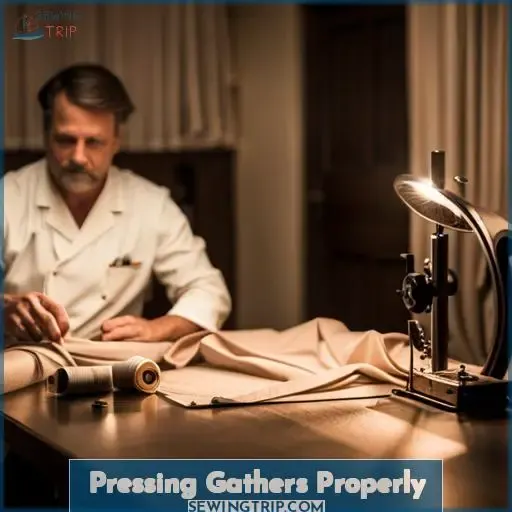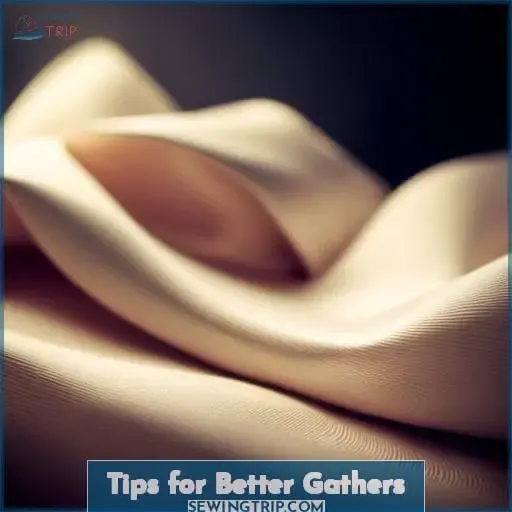This site is supported by our readers. We may earn a commission, at no cost to you, if you purchase through links.
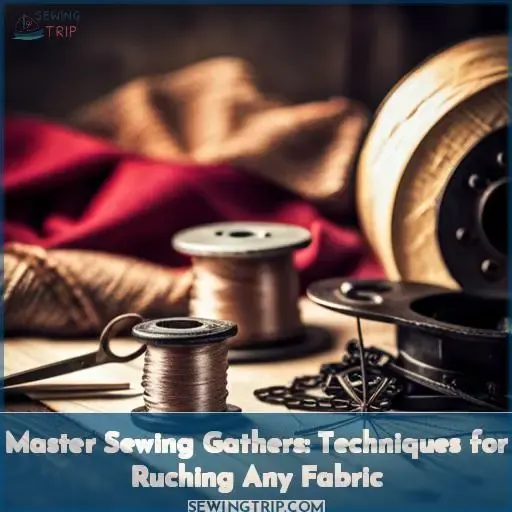
When the gathers in your fabric fall perfectly into place, creating a beautiful, flowing effect?
It’s a feeling of satisfaction that only comes from mastering the art of gathering.
In this guide, we’ll explore the different techniques for gathering fabric, from two-thread gathering to zig-zag over cord, so you can achieve perfect gathers every time.
Let’s dive in!
Table Of Contents
Key Takeaways
- Gathering creates fullness and dimension by drawing fabric into soft folds.
- Popular gathering techniques include two-thread, three-thread basting, and zigzagging over cord.
- Properly preparing the fabric is key – mark the area to gather, test stitch lengths, and check thread tension.
- Securing the gathers with pins or knots before sewing the seam helps align the gathered and flat edges.
What is Gathering on a Pattern?
On a sewing pattern, you’re looking at gathering when you see dashed lines within the seam allowance.
As a key fabric manipulation technique, gathering creates beautiful dimension and fullness, allowing you to adapt almost any design.
By simply adjusting the length of thread pulled, you control how tightly the fabric is ruched.
Whether seen as delicate pintucks or bold ruffled tiers, gathers infuse visual interest and versatility.
Though often confused with pleats, gathers lack folds’ crisp precision.
Instead, soft billows emerge organically from the fabric itself when threads draw up the edge.
Much like a curtain elegantly draped, the fabric subtly cascades.
Gently gradated or artfully placed, gathers inject grace and femininity into garments.
Embrace this flattering detail as an easy way to update necklines, sleeves, waistlines, and hemlines alike.
Preparing to Gather Fabric
Before gathering any fabric, make some preparations to ensure a proper process and finished product.
Mark the area to be gathered on your pattern and fabric pieces using clips or notches.
Consider fabric weight and choose threads accordingly – heavier fabrics may need thicker threads.
Test stitch lengths on scraps, as too long stitches on delicate fabrics can tear.
Use longer stitches (6-10 per inch) to gather.
Place alignment notches within seam allowances on both pattern pieces.
Check thread tension so gathering threads pull easily without breaking.
Properly preparing your materials allows you to evenly distribute fullness when gathering, align pieces, and prevent uneven seams or popped threads.
Adjusting notch placements and stitch lengths during testing gives you control over your gathers.
Techniques for Creating Gathers
When it comes to actually creating gathers in your project, you have a few good options.
The most common is the two-thread gathering method where you sew two rows of basting stitches and pull the threads to form gathers.
You can also try three-thread basting for more control or zig-zagging over a cord inserted in the seam allowance.
Two Thread Gathering
You can then create gathers using the two-thread gathering technique.
Sew two parallel rows of long basting stitches within the seam allowance, leaving ample thread tails.
Gently pull the bobbin threads, gathering the fabric edge evenly between both ends of stitching.
Adjust gathers by sliding them along threads before securing tightly at both ends with knots or pins.
Once ruched to your desired fullness, spread gathers smoothly and maintain control as you sew the finished seam.
Three Thread Basting
Another technique you’re using for precise control over your gathers is three-thread basting.
Sew three straight stitch lines spaced evenly within the seam allowance, experimenting with thread tension to find what works best for your fabric.
Gently pull the bobbin threads, distributing gathers evenly along the lines before tying off.
Adding that third row gives you more thread control when gathering fabric to your desired depth.
Zig Zag Over Cord
Run a sturdy piece of yarn or cord along the gathering area, then zig zag stitch over it with your machine to create gathers.
Be sure to:
- Use a strong, smooth cord that won’t get caught in the stitching
- Check thread tension
- Use a wide zig zag stitch
- Remove the cord once gathering is complete
Securing the Gathers
After creating your gathers by one of the techniques, you’ll want to secure both ends so the threads don’t come undone while working.
To secure tension, pinning methods like figure-eighting the threads around the pin head work well. Knotting techniques are also useful – simply pull the bobbin threads through to the right side and tie them off with the needle threads.
Once secured, align and pin the gathered edge to the flat edge, making sure gathers are spread evenly.
Remove the gathering stitches and press the seam away from the gathers before finishing as desired.
Even gathering distribution is key for professional results.
Sewing the Gathered Seam
Now that you’ve secured those luscious gathers, it’s time to join your ruched edge to the adjoining fabric.
Choose lightweight wovens, silks, or suiting fabrics and set your machine to a regular stitch length.
Sew right along the seam line, letting the gathers spread out evenly as you go.
If working with slippery or loosely woven fabrics, use a microtex or ballpoint needle to avoid skipped stitches.
Should your gathers become misaligned, remove the final seam stitching and redistribute them more evenly with the bobbin threads before trying again.
Take it slow, keep the fabric taut, and let the machine do the work.
Join those edges with a flawless gathered seam!
Add some visual rhythm by topstitching the finished seam.
Aligning Gathers
How evenly do you pin the gathered edge to the regular edge on the gathering side horizontally after gently pulling the bobbin threads? Even distribution creates visual balance and elevates the design.
Consider the fabric characteristics and intended form as you align.
For example:
| Fabric Type | Gathering Intention | Alignment Approach |
|---|---|---|
| Lightweight | Accent ruffle | Precision pinning |
| Midweight | Shaping skirt | Moderate easing |
| Heavy brocade | Heirloom dress | Artistic draping |
The gathers themselves impart texture and movement. Through fabric manipulation, you inject beauty and variation into the garment.
Whether regimented ruching or soft puffs, align each section purposefully.
Let the fabric and form guide your aesthetic sensibilities.
This craft intertwines science and art, logic and intuition. Master both for sublime creations.
Pressing Gathers Properly
Proper pressing maintains your gathers’ grace by ironing the seam allowance towards the flat side and carefully lifting the iron to each pleat’s apex.
Adjust the iron’s heat setting for your fabric type to prevent scorching.
Lift and lower the iron vertically at each gather’s highest point to flatten seams without mashing pleats.
Allow moisture from the fabric itself or a damp pressing cloth to relax fibers instead of saturating stitches.
Handle gathering with care as you shape it, for this decorative detail imbues clothing with a soft romance.
Finessed pressing preserves your hard work while lending comfort to the wearer.
With mindful ironwork, ruched fabrics will retain their beauty through many enchanted outings.
Tips for Better Gathers
Several tips can help you achieve better gathers when sewing:
Check thread tension.
Increased upper tension makes gathering the threads easier.
Lower the tension once gathers are set.
Mind fabric compatibility.
Delicate fabrics prone to puckering and slipping stitches complicate gathering.
Interfacing provides stability.
Don’t skimp on bobbins.
Poor quality thread breaks, undoing gathers.
Use quality thread abundant in supply.
Troubleshoot gathering issues by confirming:
- Adequate stitch length
- Thread tension balance
- Fabric preparation
- Notch transfers
Resew any detached gathers.
Finally, press gathers properly using the iron’s point, not its body.
Thoughtful gathering creates dramatic ruched effects when patience prevails.
Frequently Asked Questions (FAQs)
How much gathering should I do?
There is no single answer for how much gathering to do.
Test different amounts with your fabric type and pattern requirements.
Make several samples, adjusting gathers until you achieve the shape and fullness you desire.
The key is playing with technique rather than following a strict formula.
Can I gather knit fabrics?
Yes, knits can absolutely be gathered!
Simply use a zigzag stitch over lightweight cord to gently ease the fabric without risking runs or damage.
Take care not to overstretch; support the width with stay tape or fusible interfacing if needed.
A well-balanced gather allows the beautiful drape and flow of knits to shine.
Is there an easy way to calculate how long my gathering stitches need to be?
Unfortunately, there’s no easy formula.
Test different stitch lengths on your fabric scraps first to see what gathers well before sewing your project.
Going too long risks breaking threads or distorting fabric.
Start small, increasing length until gathering is easy to adjust.
The right length balances control and ease for your fabric.
What kind of thread works best for gathering?
For best gathering results, use quality all-purpose thread that matches your fabric weight.
Polyester thread stands up to pulling without breaking.
Use a heavier thread like topstitching thread for heavy fabrics.
Test different threads on scraps to find what sews smoothly without excessive bulk.
How do I troubleshoot uneven gathers?
Check tension.
Rethread machine.
Press seams gently, avoiding gathers.
If still uneven, remove stitches.
Re-mark gathering lines evenly.
Take care guiding fabric when sewing the final seam.
Conclusion
When gathering that chiffon for your dream dress, remember to always stabilize the fabric first.
Whether using the simple yet versatile two-thread technique or experimenting with overlock cord gathers, take care to secure threads gradually and align ruching meticulously.
Perfectly pressed gathers lend graceful movement and flawless drape to any garment.
Master these fundamentals, and you’ll achieve breathtaking style in billowing sleeves, softly draped bodices, and delicately tucked skirts.

